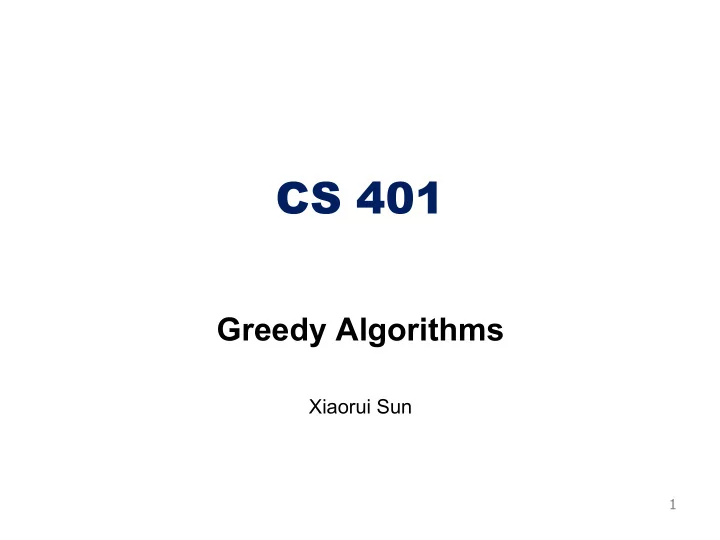

CS 401 Greedy Algorithms Xiaorui Sun 1
Directed Acyclic Graphs (DAG) Def: A DAG is a directed acyclic graph, i.e., one that contains no directed cycles. Def: A topological order of a directed graph G = (V, E) is an ordering of its nodes as ! " , ! $ , … , ! & so that for every edge (! ( , ! ) ) we have + < - . 2 3 6 5 4 1 2 3 4 5 6 7 7 1 a topological ordering of that DAG– a DAG all edges left-to-right 2
DAGs: A Sufficient Condition G has a ? G is a DAG topological order 3
Every DAG has a source node Lemma: If ! is a DAG, then ! has a node with no incoming edges (i.e., a source). Proof. (by contradiction) Suppose that ! is a DAG and it has no source Pick any node " , and begin following edges backward from " . Since " has at least one incoming edge ($, ") we can walk backward to $ . Then, since $ has at least one incoming edge (', $) , we can walk backward to ' . Repeat until we visit a node, say w, twice. Let C be the sequence of nodes encountered between successive visits to w. C is a cycle. w x u v w x u v C 4
DAG => Topological Order Lemma: If ! is a DAG, then ! has a topological order Proof. (by induction on n) Base case: true if " = 1 . Hypothesis: Every DAG with " − 1 vertices has a topological ordering. Inductive Step: Given DAG with " > 1 nodes, find a source node ' . ! − { ' } is a DAG, since deleting ' cannot create cycles. Reminder: Always remove vertices/edges to use hypothesis By hypothesis, ! − { ' } has a topological ordering. Place ' first in topological ordering; then append nodes of ! − {'} in topological order. This is valid since ' has no incoming edges. 5
A Characterization of DAGs G has a G is a DAG topological order 6
Topological Order Algorithm 1: Example 2 3 6 5 4 7 1 7
Topological Order Algorithm 1: Example 2 3 6 5 4 1 2 3 4 5 6 7 7 1 Topological order: 1, 2, 3, 4, 5, 6, 7 Running time: O(n+m) • Adjacency list • Maintain # outgoing edge for each node 8
Graph Algorithm Summary Definition of graph: directed, undirected Terminology: path, cycle, tree, degree, connected component Graph traversal: • BFS: Order nodes in successive layers based on distance from ! • DFS: More natural approach for exploring a maze; Topological order: order vertices according to precedence constraints 9
Greedy Algorithms
Greedy Algorithms • Hard to define exactly but can give general properties • Solution is built in small steps • Decisions on how to build the solution are made to maximize some criterion without looking to the future • Want the ‘best’ current partial solution as if the current step were the last step • May be more than one greedy algorithm using different criteria to solve a given problem 11
Greedy Strategy Goal: Given currency denominations: 1, 5, 10, 25, 100, give change to customer using fewest number of coins. Ex: 34¢. Cashier's algorithm: At each iteration, give the largest coin valued ≤ the amount to be paid. Ex: $2.89. 12
Greedy is not always Optimal Observation: Greedy algorithm is sub-optimal for US postal denominations: 1, 10, 21, 34, 70, 100, 350, 1225, 1500. Counterexample. 140¢. Greedy: 100, 34, 1, 1, 1, 1, 1, 1. Optimal: 70, 70. Lesson: Greedy is short-sighted. Always chooses the most attractive choice at the moment. But this may lead to a dead- end later. 13
Greedy Algorithms • Greedy algorithms Easy to produce Fast running times Work only on certain classes of problems • Hard part is showing that they are correct • Two methods for proving that greedy algorithms do work Greedy algorithm stays ahead • At each step any other algorithm will have a worse value for some criterion that eventually implies optimality Structural: Come up with a lower bound Exchange Argument • Can transform any other solution to the greedy solution at no loss in quality 14
Interval Scheduling a b b c d e e f g h h Time 0 1 2 3 4 5 6 7 8 9 1 1 0 1
Interval Scheduling Job j starts at !(#) and finishes at %(#) . • • Two jobs compatible if they don’t overlap. • Goal: find maximum subset of mutually compatible jobs. a b b c d e e f g h h Time 0 1 2 3 4 5 6 7 8 9 10 11 16
Greedy Strategy Sort the jobs in some order. Go over the jobs and take jobs that are compatible with the previous jobs already taken. Main question: • What order? • Does it give the Optimum answer? • Why? 17
Recommend
More recommend